|
Cigarette and Trade Cards of World War I
| By Cyril Mazansky
Posted October 2014
|
 |
A Brief History of British Cigarette and Trade Cards. The term cigarette cards is a loosely used term to describe all cards used for advertising. For collectors and hobbyists, the term used is cartophily, derived from the Greek meaning love of cards. It was only after the Crimean War (1854-1856) that the returning soldiers brought the habit of cigarette smoking back to England and made it a popular habit.
|
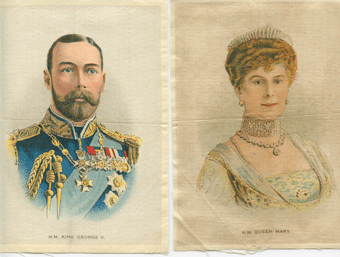
|
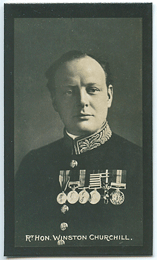
|
|
King George V and Queen Mary; Phillips,
Great War Leaders, 1916.
|
Winston Churchill photo card; Major Drapkin & Co., Celebrities of the Great War, 1916.
|
At about the same time, the Second Industrial Revolution or Technological Revolution was beginning. Tradesmen and businessmen were developing marketing skills. It was at this time that tradesmen’s cards, coinciding with developments in printing and engraving, became a more sophisticated advertising tool. The cigarette card per se began as a stiffener for the paper packets in which cigarettes were sold in the latter part of the 19th century. Originally, the stiffener had some simple form of advertising, but this rapidly evolved to developing a series of cards having a particularly interesting subject.
Wills was most likely the first British tobacco firm to issue an insert card. In 1895, their set of “Ships” and in 1896 of “Cricketers” followed in 1901 with several other sets, which firmly established the trend. Other British firms soon followed with their own sets.
|
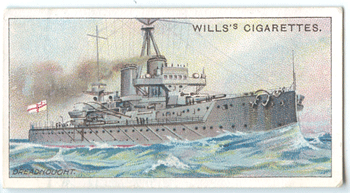
|
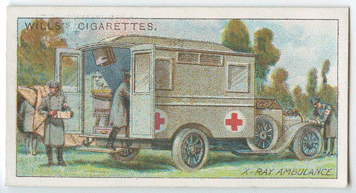
|
|
HMS Dreadnought; Wills, The World’s Dreadnoughts, 1910, No. 5.
|
X-Ray Ambulance; Wills, Military Motors, not passed by censors, 1916, No. 48.
|
It was at about this time that card collecting began as a serious hobby. When it finally reached its full maturity in the first third of the 20th century, the card subject matter could be divided into a large number of broad categories. These covered various types of leaders, military aspects, sports and other pastimes, stage, screen and radio personalities, land, sea and air transportation, nature and various novelties.
What made and still makes card collecting so fascinating a hobby? There are several reasons. There is the simple beauty of the artistry of the cards. Since these cards were produced specifically for marketing and collecting, and since they had the name of the cigarette company imprinted on them, it was in the self-interest of the issuer to produce a high-quality and informative card set. The purchaser had to be motivated to acquire the rest of the set by continuing to buy the same cigarette brand.
The other fascination with cards is the knowledge that can be gained from studying them. Although the information on some cards may be inaccurate, overwhelmingly the documentation on the reverse side of the card is authentic. In addition, with the enormous number of card sets, the cumulative information is encyclopedic. Today, despite the tendency to underplay the importance of the monetary value of the cards, many of the older and rarer sets have become very costly to purchase. The financial value of any substantial collection can no longer be ignored.
|
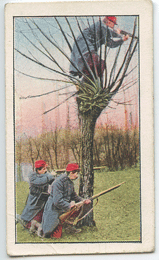
|
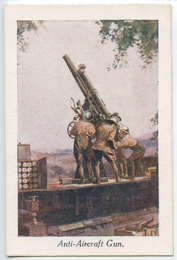
|
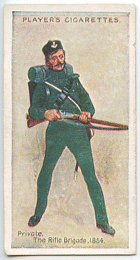
|
|
French Snipers, Battle of Yser; American Tobacco Co., World War One Scenes, 1917-18, No. 231.
|
Anti-Aircraft Gun; John Player, Artillery In Action, 1917, No. 8.
|
Crimean War soldier; John Player, Regimental Uniforms series,
1914, No. 49.
|
The era until the First World War was a vibrant one for card manufacturing and collecting. However, with the onset of this war things changed significantly, among them being the types of card subject matter. This war resulted in an outpouring of cards by the tobacco companies, due to the dual incentives of patriotism and financial reward as a result of great public interest.
The issues from this period covered almost all aspects of this major conflagration. Essentially, all of these sets had a propaganda aspect to them emphasizing the honor and bravery of the Allies, and particularly the British Armed Forces, while other sets mocked the enemy. Since most of these cards had accurate descriptions and illustrations, as well as having a wide circulation, they were subject to censorship.
Unfortunately, as a result of raw material shortages, by 1917 most card issues ceased and did not start up to any significant degree until 1922.
The period between the First and the Second World Wars has often been referred to as the golden age of cigarette cards. The larger firms were soon producing many sets. Players, Churchman, Wills, Ogden, Godfrey Phillips and Gallaher all were active in the issuing of cards. Many other smaller firms also produced fine sets, although some were restricted in their numbers. Abdulla, Mitchell and Drapkin also produced sets. One firm, Carreras, which had issued very little prior to 1914, became a prolific issuer in this period. Ardath was another tobacco company that also became active. However, there were also casualties in this period, and a number of smaller firms went out of business. One of the most notable “tragedies” from a cartophilic perspective was the firm of Taddy, which went out of business shortly after the war.
|
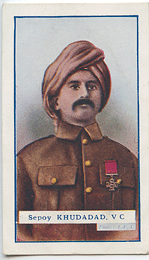
|
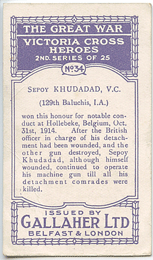
|
Sepoy Khudadad; Gallaher, Victoria Cross Heroes, 2nd Series, 1915, No. 34.
|
Following the Second World War, even when supplies became more readily available, the tobacco companies did not get back into the degree of card production that had occurred prior to the war. The variety of topics selected became very limited, and not all firms issued sets. Government restrictions on tobacco advertising further limited the incentive to issue cards. The post-war period through to the present still shows a vibrant card production, but with one difference. The field is now almost entirely dominated by the trade issues.
Cards Describing the First World War. As briefly mentioned earlier, the First World War saw the production of a variety of card sets related to different aspects of this major conflict. The remainder of this article will be devoted to a more detailed description of these various categories.
This war carried different significance to its various participants. This aspect can be gleaned from the information on the cards that covered all the Allies and to some extent, the Central Powers as well. These cards not only covered the major Allies, particularly the British, French and Russians, but also the lesser ones, and to a large extent the Colonial Allies. Many cards are devoted to the important role of these colonial allies: Indians, Australians and New Zealanders (ANZACS), Canadians and South Africans. Thus for example, in the many cards illustrating and describing the Gallipoli Campaign in 1915, there is appropriate emphasis on the heroic role of the Australians and New Zealanders. Equally as much, the German-issued sets provide their perspective on the war.
Since the majority of these cards are contemporaneous in nature, in that they were published during the war, they can now be analyzed in a retrospective historical perspective in an attempt to gain insight into the British Society and their view of the war. A striking feature that is common to a number of cards is the strongly patriotic and perhaps even jingoistic aspect of both the images on the fronts of the cards and the descriptions found mostly on the reverse of the cards. The language used in the descriptions may also be related in part to the literary style and the turn-of-century phraseology. They also aimed at boosting the morale of the viewer by glorifying the role of the Allied soldiers and describing the enemy in a derogatory manner. Since some of the cards were merely illustrations of what was both government-produced material as well as in the newsprint media, the card issuers were following what was the expected public impression of the war. This approach lends itself at times to hyperbole. Even though by the mid and latter part of the 20th century, the “myth” of this attitude was accepted; the contemporaneous nature of these cards provides significant insight into public attitudes at the time these events occurred.
Based on the images on the front of the cards and the descriptions found on the reverse of most sets, a unique but comprehensive educational and thought-provoking perspective of this war is brought to the viewer. Since these cards were originally meant mainly as a marketing tool, and then during the war as a strongly patriotic contribution, the information, although mostly accurate, was unlikely to have been subject to rigorous academic scrutiny prior to its publication on the cards. Although uncommon, there is the potential for several inaccuracies. What is probably more likely in the descriptive language of the cards is an exaggeration of praise for the British “Tommy” and the deeds of the Allies, while at the same time, there is an excessive demonization of the enemy. It is this very aspect that provides critical social and psychological insight into the society at that time.
When they were issued, the aim of the card set producers was not to provide a chronological, detailed history of the war but rather to emphasize aspects of it. Despite the potential limitations of such an approach, by the sheer depth and breadth of subject matter covered, almost every aspect of the war was included, oftentimes in some detail. The illustrations on the front of these cards came from portraits and photographs of the personalities, photographs and illustrations taken from the battlefront and on the home-front, and from works of art in public places. War artists and card illustrators were also important contributors to the illustrations. Since this was still the early days of photography, the battlefront photographs are limited. Most battle-scene images are therefore by war artists and illustrators.
The subject matter of the card sets clearly indicates how complete the coverage of that war was. Major emphasis is placed on the leaders of the countries, both regal and political, as well as the armed forces leaders who actually planned and fought the war on land, at sea, and as the war progressed, more and more in the air. This was the first modern, technologically based and industrialized war. The nature of this technology was information based, destructive and related to transportation. All these aspects are amply illustrated and described on these cards.
|
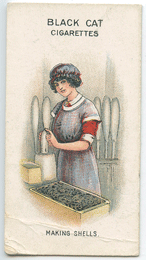
|
Making Shells; Carreras, Women on War Work, 1916, No. 11.
|
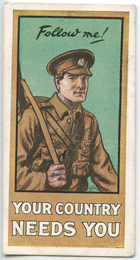
|
“Your Country Needs You”; Wills, Recruiting Posters, 1915.
|
Many card sets were devoted to all aspects of the actual fighting during the war, and they portray many hundreds of individual scenes on the battlefront. Formal recognition of the bravery of the individual soldier on the battlefield has always been standard military practice. With regard to the First World War, the card companies chose the highest award, the Victoria Cross (V.C.), as the way to illustrate the recipients and describe their various acts of valor. For an award that is truly difficult to earn, the large number of V.C.s that were awarded during the war is testimony to the tremendous, selfless acts shown by the common soldier. It is through these vignettes of individual war scenes and individual soldiers that a very good understanding, not only of the progress but also of the devastating aspects of the war, can be appreciated in its larger context.
The war was not only fought on the battlefront. It was also fought on the home-front. This occurred both in the news media, predominantly the written word with accompanying illustrations, as well as by the civilians in a variety of ways. One of the powerful propaganda media tools used was that of posters that were both patriotic as well as morale-building. Mocking the enemy in the more sophisticated newsprint media also played a prominent role in the propaganda war. These took mainly the form of cartoons, many of a satirical nature. There are a number of sets that illustrate these.
A large effort had to be made by the non-combatant civilian workforce to not only supply the war effort, but also to keep the local economy and home life functional. To a large extent, this responsibility fell to the women since much of the traditionally male-dominated workforce was fighting on the battlefield. This tremendous workforce reallocation resulted in dramatic and permanent social changes. These are all well-documented on the appropriate card sets.
Thus, through the medium of these cards, the collector and the viewer can get a comprehensive overview of the war and its impact.
-------------------------------------------
Cyril Mazansky is a retired physician who has had a longstanding interest in British and European history and military history. He owned a large collection of British military swords which he and his wife donated to Brown University. He has written a book, British Basket-Hilted Swords, published by the Royal Armouries of Great Britain. He has been collecting, predominantly British cigarette and trade cards, for 30+ years. Cyril Mazansky’s book, The First World War on Cigarette and Trade Cards: An Illustrated and Descriptive History, will be available from Schiffer Publishing in March 2015. Schiffer Publishing, Ltd. is a family-owned, independent publisher of high-quality books. From their traditional subjects of antiques and collectibles, arts and crafts, and military history, Schiffer has expanded its catalog to publish books on: contemporary art and artists; architecture and design; food and entertaining; and children’s books. Visit www.schifferbooks.com
to explore a backlist of 5,000+ titles or call 610-593-1777 to request a catalog.
Editor’s Note: There is no national World War I Memorial in Washington, D.C., but the World War One Commission is working to change that. Learn more at http://worldwar-1centennial.org.
|